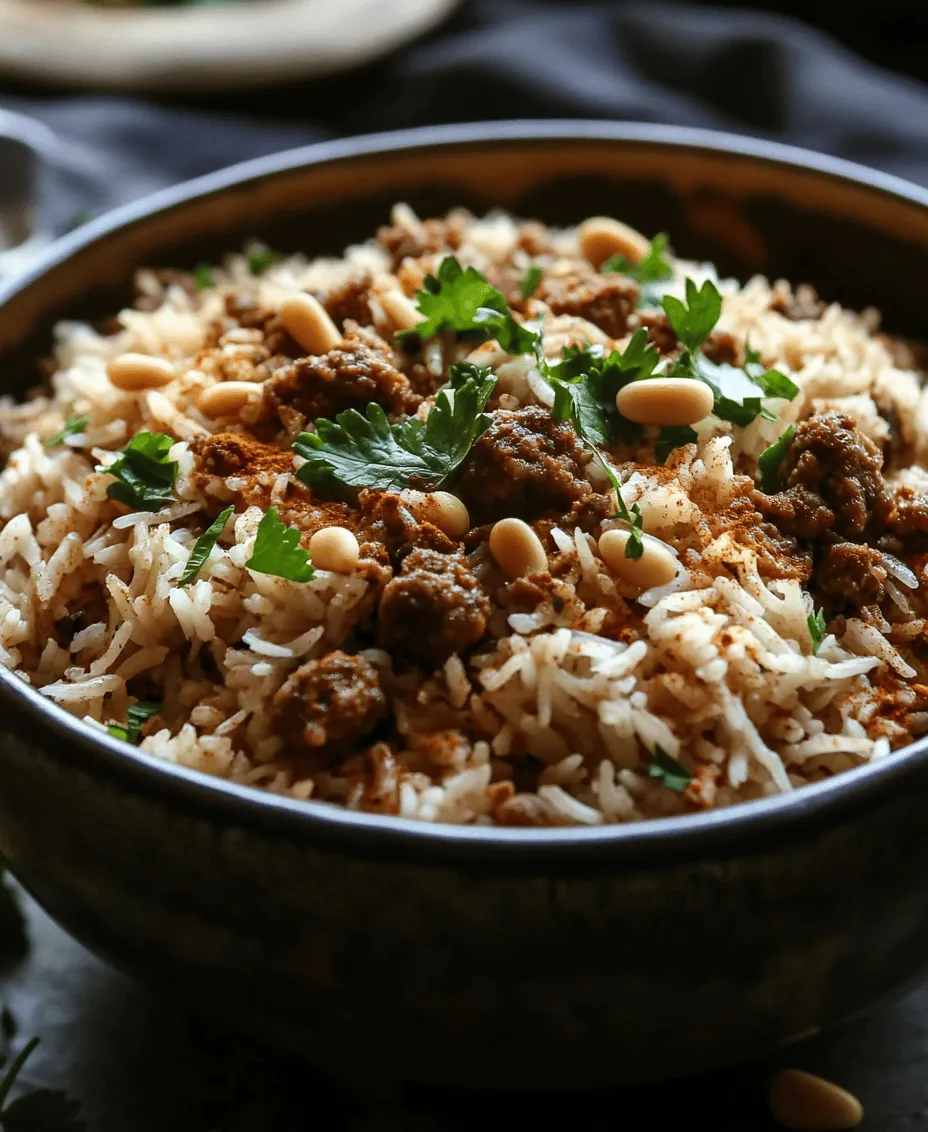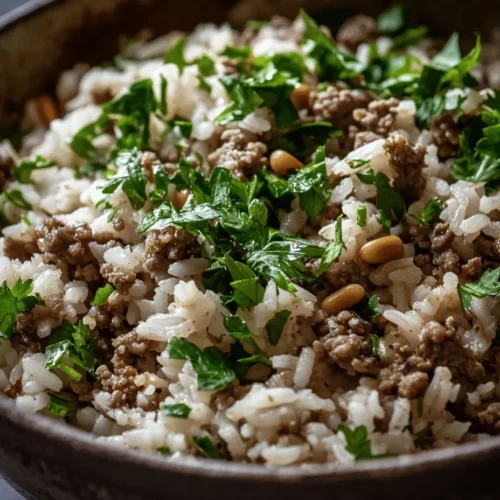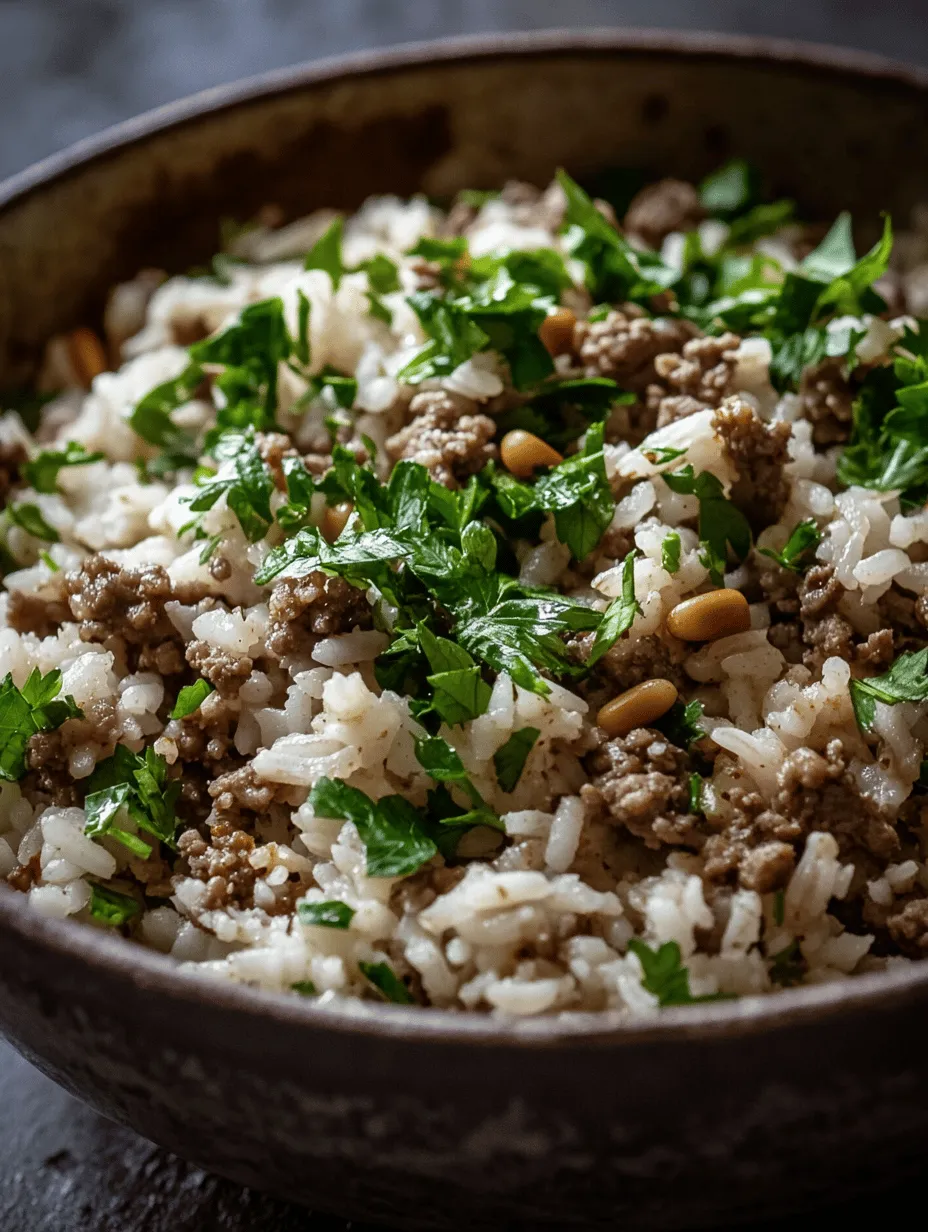Introduction
Hashweh Delight is a traditional Middle Eastern dish that beautifully encapsulates the rich tapestry of flavors and culinary heritage found within the region. Known for its hearty composition and aromatic profile, Hashweh is a beloved staple that resonates with families and food enthusiasts alike. This dish, which translates to “stuffed” or “filled,” typically showcases a delightful combination of basmati rice, ground meat, and an array of spices that reflect the diverse cultures of the Middle East.
The cultural significance of Hashweh Delight extends beyond just its ingredients; it represents a communal experience, often prepared during gatherings, celebrations, and special occasions. Families come together to share this dish, passing down recipes and techniques through generations. Its popularity is a testament to its comforting nature and the ability to bring people together around the dinner table. Hashweh can serve as a satisfying main course or a flavorful side dish, making it a versatile choice for any meal.
As we delve deeper into this culinary adventure, we will explore the essential ingredients that make Hashweh Delight so special. Each component plays a vital role in creating the dish’s signature flavor and texture, ensuring that every bite is a celebration of Middle Eastern gastronomy.
Understanding the Ingredients
Basmati Rice
At the heart of Hashweh Delight lies basmati rice, an aromatic long-grain variety celebrated for its delicate fragrance and fluffy texture. Originating from the Indian subcontinent, basmati rice has become a staple in Middle Eastern cuisine, holding a special place in numerous traditional dishes. The grains are known for their ability to absorb flavors while remaining separate and light when cooked, making them the perfect base for Hashweh.
The flavor profile of basmati rice is subtly nutty, which pairs beautifully with the spices and meats used in Hashweh. When cooked properly, the grains expand and become tender, creating an ideal canvas for the dish’s rich flavors. In addition to its culinary attributes, basmati rice is gluten-free and boasts a low glycemic index, making it a healthy choice for those looking to maintain balanced dietary habits.
Exploring Ground Meat Options
The choice of ground meat is crucial in crafting the unique essence of Hashweh Delight. Traditional recipes often feature ground lamb or beef, each bringing distinct flavors and textures that contribute to the dish’s overall appeal. Lamb offers a rich, slightly gamey taste that pairs harmoniously with the aromatic spices, while beef provides a more robust and hearty flavor.
For those seeking plant-based alternatives, ground meat substitutes such as lentils or textured vegetable protein can be used, offering a nutritious and delicious option without sacrificing flavor. Each type of meat or substitute brings its own set of nutritional benefits, including protein, iron, and essential vitamins, making Hashweh a wholesome meal for various dietary preferences.
The Role of Aromatics
No dish is complete without the foundational flavors provided by aromatics, and Hashweh Delight is no exception. Onions and garlic serve as the backbone of this recipe, enhancing its overall flavor profile. When sautéed, onions develop a sweet and caramelized essence, while garlic adds a pungent kick that elevates the dish to new heights.
The combination of these aromatics not only enriches the taste of the Hashweh but also contributes to the comforting aroma that fills the kitchen as it cooks. Together, they create a savory base that allows the other ingredients to shine, ensuring that every bite is infused with a depth of flavor that is quintessential to Middle Eastern cuisine.
The Flavorful Spices
A hallmark of Hashweh Delight is its carefully selected blend of spices, each contributing to the dish’s distinctive taste. The combination of cinnamon, allspice, cumin, and nutmeg creates a warm and inviting flavor profile that is both complex and comforting.
– Cinnamon brings a sweet warmth that complements the savory elements of the dish, while allspice adds a hint of clove-like spiciness that enhances the overall depth of flavor.
– Cumin, with its earthy and nutty notes, contributes a warm richness that is characteristic of many Middle Eastern dishes.
– Nutmeg offers a subtle sweetness that rounds out the spice mixture, creating a harmonious balance among the flavors.
This aromatic spice blend not only serves to elevate the taste of Hashweh but also reflects the cultural influences and history of the region, making each bite a journey through time and tradition.
Pine Nuts: A Crunchy Contrast
To add texture and a delightful crunch, toasted pine nuts are often sprinkled over Hashweh Delight before serving. These small, buttery nuts provide a contrasting texture to the dish, enhancing the overall eating experience. Pine nuts are not only flavorful but also packed with nutritional benefits, including healthy fats, protein, and essential vitamins and minerals.
Toasting the pine nuts is an essential step, as this process intensifies their flavor and brings out their natural oils. A light golden-brown color indicates that they are perfectly toasted, adding a fragrant nuttiness to the final dish. This finishing touch not only contributes to the flavor but also adds visual appeal, making Hashweh Delight a feast for the senses.
Broth as a Cooking Medium
The choice of broth used in Hashweh Delight can significantly influence the dish’s flavor profile. While chicken broth is a popular choice due to its rich and savory qualities, vegetable broth offers a lighter alternative that accommodates vegetarian and vegan diets.
Using broth as the cooking medium infuses the rice with additional flavor, ensuring that each grain is seasoned perfectly. Chicken broth adds depth and heartiness, while vegetable broth allows the spices and aromatics to shine through, making it a versatile option for various dietary preferences. When preparing Hashweh, consider the flavor profile you desire and choose the broth that best complements your chosen ingredients.
Step-by-Step Cooking Instructions
Now that we have explored the essential components of Hashweh Delight, it’s time to dive into the cooking process. Follow these step-by-step instructions to create your own delicious version of this beloved Middle Eastern dish:
1. Prepare the Ingredients: Begin by gathering all the necessary ingredients, including basmati rice, your choice of ground meat, onions, garlic, and the spice blend. If using pine nuts, toast them in a dry skillet until golden brown.
2. Sauté the Aromatics: In a large pot or skillet, heat some olive oil over medium heat. Once hot, add finely chopped onions and sauté until they become translucent. Then, add minced garlic and cook for an additional minute, allowing the flavors to meld.
3. Brown the Meat: Add the ground meat to the pot, breaking it apart with a wooden spoon. Cook until browned and fully cooked, ensuring that the meat absorbs the flavors from the aromatics. Season with salt and pepper to taste.
4. Incorporate the Spices: Once the meat is cooked, sprinkle in the cinnamon, allspice, cumin, and nutmeg. Stir well to combine, allowing the spices to toast slightly and release their fragrant oils.
5. Add the Rice: Rinse the basmati rice under cold water until the water runs clear. This step removes excess starch and ensures that the rice cooks up fluffy. Add the rinsed rice to the pot, stirring to combine it with the meat and spices.
6. Pour in the Broth: Carefully add your choice of broth to the pot, ensuring that the rice is fully submerged. Bring the mixture to a boil, then reduce the heat to low, cover, and let it simmer. Cook for approximately 15-20 minutes, or until the rice is tender and has absorbed the liquid.
7. Fluff and Serve: Once the rice is cooked, remove the pot from the heat and let it sit, covered, for a few minutes. Fluff the rice gently with a fork, and then transfer the Hashweh Delight to a serving dish. Top with toasted pine nuts for added flavor and crunch.
As you embark on this culinary journey, you will discover the joy of creating Hashweh Delight in your own kitchen. With its rich history, cultural significance, and delightful flavors, this dish is sure to become a cherished addition to your recipe repertoire. Stay tuned for more insights and serving suggestions in the next part of this article!

Preparing the Rice
The foundation of any great Hashweh Delight lies in the rice. Using basmati rice is traditional for this dish, known for its long grains and delicate nutty flavor. To ensure that your rice turns out fluffy and well-cooked, it’s essential to follow the proper rinsing and soaking techniques.
Importance of Rinsing and Soaking Basmati Rice
Rinsing basmati rice is crucial for removing excess starch, which can make the rice gummy when cooked. To rinse, place the rice in a fine-mesh strainer and run it under cold water, gently swishing it around with your hand until the water runs clear. This process typically takes a few minutes and is worth the effort for achieving the perfect texture.
Soaking the rice is another step that shouldn’t be overlooked. It allows the grains to absorb some water, which helps them cook evenly and prevents them from breaking during the cooking process. Aim to soak the rice for at least 30 minutes, but if you have time, soaking for up to two hours can enhance the texture even further.
Tips for Achieving the Perfect Texture
1. Use the Right Water Ratio: A common ratio for cooking basmati rice is 1 cup of rice to 1.5 cups of water. However, this can vary based on the age and brand of the rice, so be sure to check the package instructions.
2. Bring to a Boil and Simmer: Once the rice is soaked and rinsed, bring the water to a boil in a pot. Add a pinch of salt for flavor, then reduce the heat to low, cover the pot, and let it simmer. This technique allows the rice to cook thoroughly without losing moisture.
3. Let It Rest: After cooking, let the rice sit, covered, for about 10 minutes. This resting period allows any remaining steam to finish cooking the rice and helps to separate the grains.
Cooking the Meat
Now that the rice is prepared, it’s time to focus on cooking the meat, which is typically ground lamb or beef in Hashweh Delight. The meat is enhanced by the aromatic flavors of onions and garlic, which form the base of this dish.
Techniques for Sautéing Onions and Garlic
Start by finely chopping one large onion and a few cloves of garlic. Heat a few tablespoons of olive oil in a large skillet over medium heat. Once the oil is hot, add the onions and sauté them until they become soft and translucent, about 5-7 minutes. This step is crucial as it builds the flavor base for the meat.
Once the onions are softened, add the minced garlic and continue to sauté for another minute, being careful not to let the garlic burn—burnt garlic can impart a bitter flavor to the dish.
Tips for Browning Meat Effectively
1. Use High Heat: After the onions and garlic are sautéed, increase the heat to medium-high before adding the ground meat. This will help to brown the meat, adding depth to the flavor.
2. Do Not Overcrowd the Pan: If you’re cooking a larger batch, consider browning the meat in batches to avoid overcrowding. This allows the meat to sear properly rather than steam.
3. Season Early: As you cook the meat, sprinkle in your seasonings—such as salt, pepper, and spices like cinnamon and allspice—early in the cooking process. This helps the flavors infuse into the meat.
Combining Flavors
Once the meat is browned and cooked through, it’s time to combine the flavors and build the dish.
Importance of Seasoning During Cooking
Seasoning is critical in elevating the overall taste of Hashweh Delight. While browning the meat, ensure you taste and adjust the seasoning as necessary. A well-seasoned meat mixture will enhance the flavor of the rice when combined.
How to Balance Spices for Optimal Flavor
The key spices in Hashweh Delight often include cinnamon, allspice, and sometimes nutmeg. Start with small amounts, as spices can quickly overpower a dish. A good starting point is:
– 1 teaspoon of ground cinnamon
– ½ teaspoon of allspice
– A pinch of nutmeg (optional)
Mix these spices into the meat mixture, and taste as you go. Remember, you can always add more, but you can’t take it out!
Cooking the Rice
Now that you have a flavorful meat mixture, it’s time to bring everything together with the rice.
Techniques for Simmering Rice to Perfection
Once the meat is seasoned and the rice is prepped, it’s time to combine them. Add the soaked rice to the meat mixture in the skillet. Carefully fold the rice into the meat, ensuring that it is evenly distributed. Then, pour in the appropriate amount of liquid—usually the same amount of water used for soaking the rice—into the skillet.
Bring the mixture to a gentle boil, then reduce the heat to low, cover the skillet, and let it simmer for about 20 minutes. This allows the rice to absorb the flavors from the meat and spices while cooking through perfectly.
Importance of Resting the Rice After Cooking
After the rice has cooked for 20 minutes, turn off the heat but keep the skillet covered for another 10 minutes. This resting period allows the rice to finish cooking through steam, ensuring a fluffy texture and infusing it with the rich flavors of the meat mixture.
Toasting Pine Nuts
Pine nuts are a delightful addition to Hashweh Delight, adding a nutty flavor and a pleasing crunch.
Guidelines for Preventing Burning and Achieving Golden Perfection
To toast pine nuts, heat a dry skillet over medium heat. Once the pan is hot, add the pine nuts in a single layer. Toast them for about 3-5 minutes, stirring frequently to prevent burning. Keep a close eye on them, as they can go from perfectly toasted to burnt in seconds. When they’re golden and fragrant, remove them from the heat and set aside.
Serving Suggestions
When it’s time to serve your Hashweh Delight, presentation is key to showcasing this beautiful dish.
Ideas for Plating and Garnishing Hashweh Delight
1. Use a Large Platter: Serve the Hashweh Delight on a large platter for a communal dining experience. Fluff the rice with a fork to separate the grains, then mound it in the center.
2. Garnish with Pine Nuts and Fresh Herbs: Sprinkle the toasted pine nuts over the rice for added texture. Fresh herbs like parsley or cilantro can add a pop of color and freshness.
3. Add a Side of Yogurt or Salad: Serve with a side of plain yogurt or a fresh salad to balance the rich flavors of the dish. A simple cucumber and tomato salad dressed with lemon juice and olive oil complements Hashweh Delight beautifully.
Nutritional Information
Hashweh Delight is not only delicious but also packed with nutritional benefits from its wholesome ingredients.
Overview of Key Nutritional Components in Hashweh
1. Protein: The ground meat provides a good source of protein, essential for muscle repair and overall health.
2. Carbohydrates: Basmati rice offers complex carbohydrates, providing energy and promoting digestive health due to its fiber content.
3. Healthy Fats: Olive oil and pine nuts contribute healthy fats that are beneficial for heart health.
Health Benefits of the Ingredients Used
The spices used in Hashweh Delight, such as cinnamon, have anti-inflammatory properties and can contribute to heart health. Additionally, herbs and vegetables, when added, can increase the vitamin and mineral content of the dish.
Suggestions for Modifications to Suit Dietary Preferences
– Vegetarian Option: Replace the meat with lentils or chickpeas for a vegetarian version that retains the delicious flavor.
– Gluten-Free: Hashweh Delight is naturally gluten-free, making it suitable for those with gluten intolerances.
Conclusion
Hashweh Delight is a beautiful representation of Middle Eastern cuisine, combining rich flavors, aromatic spices, and wholesome ingredients. The careful layering of flavors—from the sautéed onions and garlic to the perfectly cooked rice and meat—creates a dish that is both satisfying and nourishing.
This recipe not only brings together a variety of textures and tastes but also carries cultural significance, often shared during family gatherings and special occasions. I encourage you to try making Hashweh Delight at home, embracing the tradition and flavors it offers.
Whether you’re serving it for a festive occasion or a comforting weeknight dinner, Hashweh Delight is sure to impress. Its versatility allows it to fit seamlessly into various culinary contexts, making it a beloved dish in many households. Enjoy this delightful recipe, and let it transport you to the heart of Middle Eastern cooking right in your kitchen.



